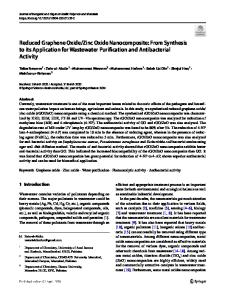Electrically reduced graphene oxide for photovoltaic application
- PDF / 932,718 Bytes
- 9 Pages / 584.957 x 782.986 pts Page_size
- 72 Downloads / 452 Views
Advanced Electronic and Nano-Materials Laboratory, Department of Physics, Jamia Millia Islamia (A Central University), New Delhi 110025, India SPECLAB, Department of Physics, University of Puerto Rico, San Juan, Puerto Rico 90036, USA a) Address all correspondence to this author. e-mail: [email protected] 2
Received: 3 December 2018; accepted: 16 January 2019
We report Electrically reduced graphene oxide (GO) and n-type Si heterostructure junction-based photovoltaic cell. The transition of the insulating properties of GO to that of semi-conducting was achieved by applying electric voltages using 5, 10, and 15 V biasing. The photovoltaic device I–V characteristics corresponding to the increasing (5–15 V) reduction voltages, obtained on exposure of 25 mW/cm2 visible light, showed approximately same fill factor with increased efficiency. The maximum efficiency of 1.12% was observed under ultraviolet light exposure for photovoltaic cell consisting GO reduced using 15 V reduction voltage. GO was synthesized using the modified Hummers’ technique and characterized by X-ray diffraction (XRD), ultraviolet– visible (UV-Vis) spectroscopy, Fourier transform infrared (FTIR) spectroscopy, and scanning electron microscopy (SEM). The GO characteristic XRD peak corresponding to plane (001) was observed at 9.16°. The UV-Vis spectrum for GO displayed an absorption peak at 228.5 nm, and the corresponding Tauc plot analysis provided a band gap of 4.74 eV. The FTIR analysis showed presence of C=O (1713 cm−1), C=C (1627 cm−1), C–OH (1418 cm−1), C–O–C (1252 cm−1), C–O (1030 cm−1), and C–H (827 cm−1) functional groups in GO.
Introduction Graphene oxide (GO) is the functionalized graphene sheet, which besides being the precursor for the graphene production show very interesting properties. It has certain band gap, which is absent in the pure graphene sheet, due to which it has great potential in the field of optical applications [1, 2]. Graphene is a monolayer of two-dimensional carbon set in hexagonal structure [3]. It has drawn substantial attention due to its exceptional electrical and optical properties. Due to graphene’s unique properties, it is used in electrochemical devices [4], transparent electrodes [5], novel nanocomposites [6], fieldeffect transistors [7], ultrasensitive sensors [8], etc. Graphene has been known to be synthesized by chemical vapor deposition [9], mechanical exfoliation [10], electrochemical exfoliation [11], solvothermal synthesis [12], and reduction of GO [13]. Benjamin Brodie was the first person who synthesized GO in 1859. GO is assumed to be the out-of-order analogue of the extremely conducting crystalline graphene. Graphene has engrossed the curiosity of physicists due to its exceptional electronic structure with linearly dispersed Dirac electrons. The
ª Materials Research Society 2019
insulating and flawed characteristics of GO do not permit the observation of elementary two-dimensional condensed matter effects. However, chemists and material scientists are interested to study this material due to its var
Data Loading...











